THE SYDNEY CRICKET Ground and the Manuka Oval in Canberra—venues for the three-match ODI series between India and Australia—are “sold out”. But, they will be at 50 per cent capacity owing to Covid-19 protocols. After two months of playing to empty stands in the Indian Premier League, the players will finally have a real audience.
Team India, led by Virat Kohli, returns to Australia as holders of the Border-Gavaskar Trophy. The three ODIs and T20Is will be a prelude to the real deal—the four-match Test series. The first Test is a day/night match in Adelaide. It will be India’s first pink ball match away from home.
For Cricket Australia (CA), close to AUD300 million hinges on India’s visit. It has gone all out to ensure a smooth process. It got India’s request for soft quarantine cleared (they can train every day) and flew in players from South Australia early to ensure they do not get stuck.
Australia are bolstered by the return of Steve Smith and David Warner. Both missed the last Test series against India, in 2018-2019, because of the sandpapergate ban. Former India captain Anil Kumble told
THE WEEK: “Prior to their ban Smith and Warner accounted for 40 to 45 per cent of the team’s runs.ÅTheir return obviously is a huge advantage for Australia.”ÅSmith, the No 1 ranked Test batsman, had a tough time facing short balls by Jofra Archer in England and Neil Wagner in New Zealand. But, those were bowled at around 150kmph. All eyes will be on how Jasprit Bumrah and company plot and execute against Smith.
Marnus Labuschagne, the South African-born player who came on as the first ever concussion substitute (for Smith) during the Ashes in 2019, has had a superb run ever since. His batting statistics are right up there with Smith’s (1,459 runs in 14 matches, four 100s and an average of 63.43). Former Australia pacer Michael Kasprowicz said Labuschagne has adapted his game to suit conditions. “He will pose a big challenge, he is a real competitor, there is a desire to do well,” he said. Australia have promising youngsters Cameron Green and Will Pucovski on the bench.
India will be without Rohit Sharma for the ODI and T20I series, and Kohli after the first Test in Adelaide (Ajinkya Rahane will take over the captaincy). That means opportunities for the likes of Shreyas Iyer and Shubman Gill. The star of the last series, Cheteshwar Pujara, will also be vital. Last time, Pujara batted for 22 hours in the four Tests, scoring 571 runs, including three centuries. He never looked under pressure during long stays at the crease—a quality that is rare in modern cricket.
Kumble said Pujara, India’s No 3, is the team’s batting fulcrum. “I am glad someone is talking about Cheteshwar and his value,” said the spin legend. “His success will decide how well India does, especially in Kohli’s absence.” Kasprowicz said: “It is great to see Pujara, someone who is batting [against] time. He is definitely the key wicket.”
The bowling attacks are fairly even. Both teams have pace and variety, though India may miss Ishant Sharma. Navdeep Saini’s raw pace could complement the guile and experience of Mohammed Shami, Bumrah and Umesh Yadav. There is also the exciting prospect of Mohammed Siraj.
Bumrah was the first Indian to take five-wicket hauls in Tests in England, Australia, South Africa and the West Indies. He was destroyer-in-chief the last time with 21 wickets at an average of 17. Dangerous with both the new ball and the old, Bumrah returns to Australia with a formidable record—68 wickets in 14 Tests at an average of 20.33.
Kumble said the absence of a left-hand pacer, like Australia’s Mitchell Starc, would not be a disadvantage for India. “The bowling attack has enough variety,” he said. “You need to find a bit of reverse swing in Australia. If India can find that it will be a major challenge.”ÅKumble, Shami’s coach in IPL 2020, said the pacer would take confidence from his recent success into the series.
The hosts, too, have strength in depth in their bowling department, especially pace. “[Pat] Cummins, Starc and [Josh] Hazlewood keeping out the others coming through is indicative of the depth,” said Kasprowicz. “James Pattinson is in the squad, so is [Michael] Neser, Queensland player of the year for the last three to four years.”
On Starc, Kasprowicz said: “Swinging the ball at 150kmph always helps! Yeah, you can compare him to fantastic left-arm pacers in history like Wasim Akram. He can get wickets at any point in the game. That is what Starc has shown. And if used the right way, that is important.”
Team India needs its batting to click. “If your opening partnership is good and Pujara comes good, too, then it is game on,” said Kumble. “To be 40-3 and then try to build an innings will be a massive effort.” For a change, it will not be the bowling but the batting that will decide India’s fate Down Under.


